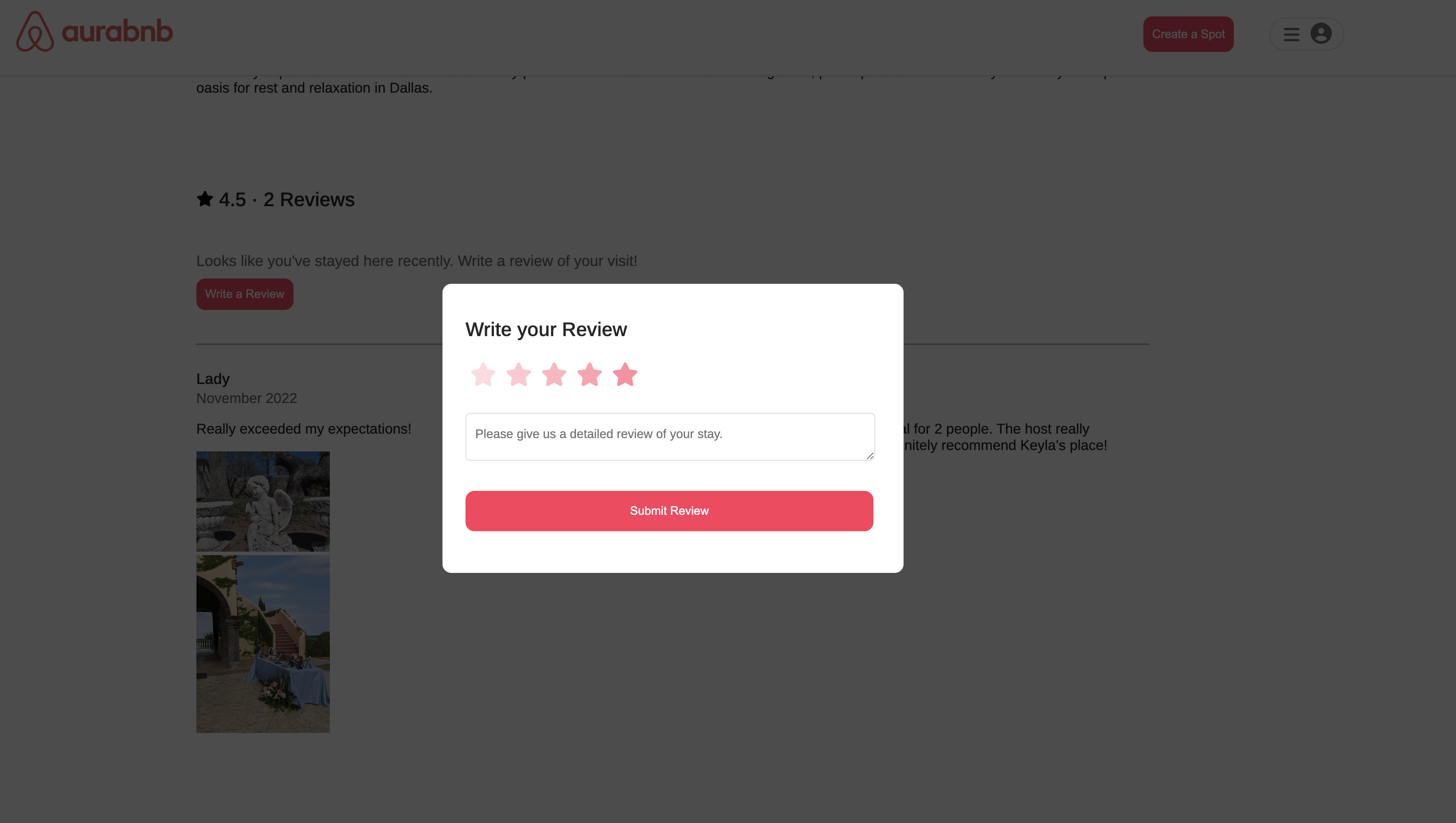Welcome to Aurabnb. Aurabnb is an online space-sharing platform that allows guests to book places for their vacations, business trips and more inspired by Airbnb
Explore Aurabnb Site: https://airbnb-skimby.herokuapp.com/
- JavaScript
- HTML
- CSS
- React
- Redux
- Node.js
- Express.js
- Sequelize
- Sqlite3
- Heroku
- AWS
- Create a new user
- Log In user
- Demo user login
- Create new spot, edit, view and delete spot (Add images to the spot included in edit feature.)
- Create new review, edit, view and delete review (Add images to the review included edit feature.)
- Allows users to create, edit and delete review if the user has an existing booking at the spot.
- Carousel gallery on landing page to view images prior to clicking to the individual spot.
- Full screen gallery once on spot page to get detailed look of images.
- Modal forms allow you to create a spot at whatever page you are on as opposed to taking you to a specified route.
The 'Create a Spot' form was initially implemented as a link to a route. In converting it into a modal form, I lost information that would be obtained from the route's parameters (ex: :spotId and :reviewId). My 'Create a Spot' form also functioned as my 'Edit a Spot' form and the type of form was dependent on whether a 'SpotId' was present or not. If the 'SpotId' is presents, that means the spot exists and it is an 'Edit a Spot' form. If the spotId is null, then the spot does not exist and it is a 'Create a Spot' form.
Because I removed the form's parameters, I had to strategize a new way to determine if the spot existed or not. I decided to prop thread a state (either 'newSpot' or 'editForm') into the 'SpotFormModal' and replace the conditions that determined which form it should render.
// 'newSpot' is a state that is prop threaded into the 'SpotFormModal' to signal the form
should 'Create a Spot'.
const Navigation = ({ isLoaded }) => {
const history = useHistory();
const dispatch = useDispatch();
const [newSpot] = (true);
const [showMenu, setShowMenu] = useState(false);
...
{/* IF LOGGED IN ... */}
{isLoaded && sessionUser && (
<>
<li >
<SpotFormModal newSpot={newSpot} />
</li>
...
// 'editForm' is a state that is prop threaded into the 'SpotFormModal' to signal the form
should 'Edit a Spot'.
const GetSpot = () => {
const dispatch = useDispatch();
const history = useHistory();
let { spotId } = useParams();
spotId = parseInt(spotId);
const [userOwned, setUserOwned] = useState();
const [bookedUser, setBookedUser] = useState(false);
const [hasNoImages, setHasNoImages] = useState();
const [editForm] = useState(true);
...
{userOwned && (
<>
<div className="user-owned-functions">
<SpotFormModal editForm={editForm} />
<AddImagesFormModal />
<button onClick={handleDelete}>Delete Spot</button>
</div>
</>
)}
// Both props passed in determine which form should be rendered for the viewer.
const SpotFormModal = ({ editForm, newSpot }) => {
const [showModal, setShowModal] = useState(false);
const [isNewForm, setIsNewForm] = useState()
return (
<>
{newSpot && (
<li>
<button id='nav-button' onClick={() => {
setIsNewForm(true)
setShowModal(true)
}}>Create a Spot</button>
</li>
)}
{editForm && (
<button onClick={() => {
setIsNewForm(false)
setShowModal(true)
}}>Edit Spot</button>
)}


